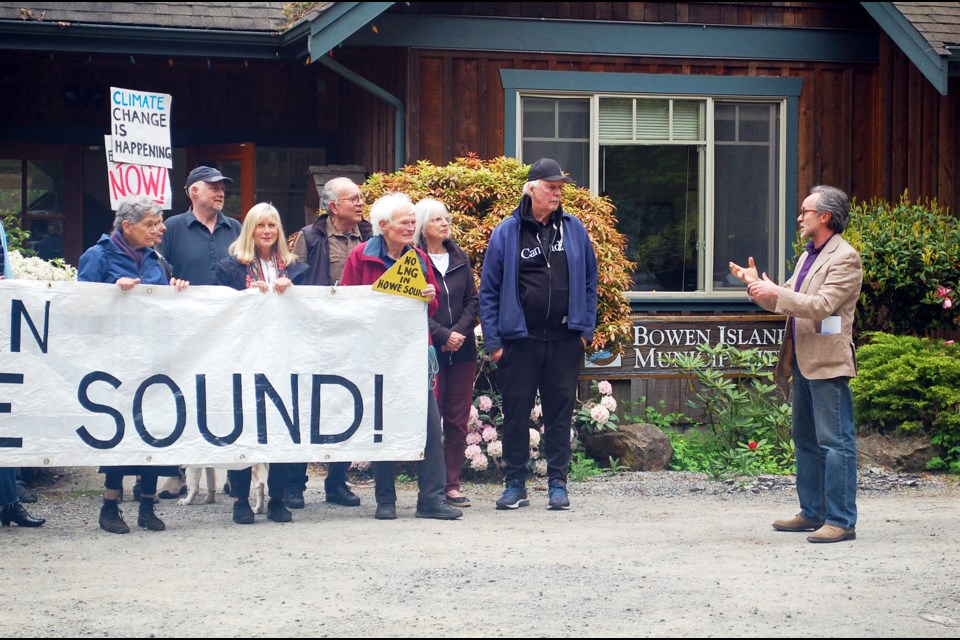Woodfibre LNG appeared before Bowen council for the first time in several years on Tuesday to provide an update on their facility being constructed outside of Squamish.
The presentation was preceded by a demonstration outside municipal hall, where around 25 protestors, some with environmental organization My Sea to Sky, voiced their opposition to the LNG (liquefied natural gas) plant. Holding signs and a banner reading “Stand up for an LNG-free Howe Sound,” participants spoke with councillors before the councillors went in to hear the company’s remarks.
Bowen council has passed several motions stating their opposition to the project since 2015, most recently in 2020.
Anton van Walraven organized the impromptu protest. “It’s an opportunity for us to let council and Woodfibre know that there’s still opposition against the project, and it’s even more urgent because as we all can see climate change is happening around the world and in our backyard,” he says.
Tracey Saxby, executive director with My Sea to Sky, was also at the demonstration. "It’s been more than eight years that communities around Howe Sound have come together to stop Woodfibre LNG and the pipelines and tankers that were associated with this proposed project. It’s amazing to be here this evening and see this turnout on very short notice," said Saxby.
van Walraven said he has doubts regarding one of Woodfibre LNG’s primary claims, that energy produced at the Squamish site will be cleaner than equivalent energy produced at coal plants in Asia. The company said during their presentation they’re running a scenario analysis to confirm this, along with an analysis to measure the full emissions impact of producing LNG at the plant, including work done outside the facility.
“The world needs energy, there’s a clear transition from coal into LNG, and later on other types of energy production… But the demand for energy is there,” said Christian Ruilova, marine manager for the company.
“It would be a missed opportunity because that LNG demand would be produced by other sources in other parts of the world, that would not have potentially the same levels of environmental concerns that we have,” said Ruilova.
Woodfibre LNG attempts to convince Bowen of project benefits
Woodfibre also used their time to stress what they say are local benefits to the Sea to Sky region, including Bowen Island. These included job opportunities for residents – 700 during peak construction in 2025 and 100 once complete – donation, sponsorship and partnership opportunities with these communities, and reconciliation efforts with Indigenous peoples, such as Squamish Nation.
Julia Diamond, senior manager of government relations, told council the plant will also be environmentally beneficial. Diamond said it will be operated by an electric drive, the second such facility in North America where this is the case, which will make it the lowest emissions facility in the world, and 1/10 the impact of a comparable plant. She added the plant hopes to be operating at net-zero by 2050.
“We think that our project can do all of it,” said Diamond. “Protect the environment, enhance the environment on site, contribute to emissions reductions, support global energy security and the global energy transition in a way that is socially responsible, minimize impact to the environment, create jobs for British Columbians, create revenues for government and have positive benefits for communities and young people for generations to come.”
Construction is expected to begin next year, with the plant operational in 2027.
Councillors remained hesitant following the presentation.
Coun. David Hocking requested the results of the scenario analysis being conducted, while Coun. Rob Wynen wondered if the project is compatible with a presentation earlier in the evening requesting the municipality proclaim the next 12 months “Year of the Salish Sea”.
Coun. Sue Ellen Fast questioned the usefulness of Woodfibre’s environmental study, first conducted in 2016.
Fast said that since then there’ve been several environmental developments on the island, including population changes among whales, dolphins and glass sponge reefs, a Hazard, Risk and Vulnerability Assessment, the establishment of a UNESCO biosphere, the declaration of a climate emergency, events such as last year’s heat dome, and more. Fast says she didn’t believe these recent events were taken into account and that the plant’s operation would in fact make these existing problems worse.
Regarding transport safety questions, Ruilova says the tankers will each be escorted by a pair of tug boats and will reduce their speed when entering the waters around Bowen. The vessels will be supplied by BP, and be around 290 metres long and 40 metres wide.
Ruilova said he doesn’t anticipate delays to ferry service and that Woodfibre will coordinate with BC Ferries to avoid scheduling delays. He estimates a tanker will pass by Bowen every eight to 10 days.
Coun. Maureen Nicholson asked what the “cost” to Bowen would be. Woodfibre responded on a global scale, saying the Squamish plant will offset the emissions equivalent of 700,000 cars a year compared to producing the fuel in Asia.
But Nicholson reminded Woodfibre she’d asked the question on a local scale. “There is a decreased sense of safety on this island related to this project – that is a cost to Bowen Island.”
“I think it would be really important to think more broadly about the costs to Bowen Island and Bowen Islanders if this project were to proceed, otherwise you’re not going to get very far with a significant part of your audience here.”



